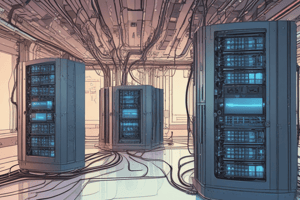Podcast
Questions and Answers
What is the purpose of having two cables with different signals in twisted pair cabling?
What is the purpose of having two cables with different signals in twisted pair cabling?
- To increase the speed of data transmission
- To reduce the cost of cabling infrastructure
- To support multiple types of networks simultaneously
- To identify and correct interference that may have occurred through the wire (correct)
What is the significance of the twist rate in twisted pair cabling?
What is the significance of the twist rate in twisted pair cabling?
- It affects the speed of data transmission
- It determines the maximum distance of data transmission
- It helps to identify and correct interference
- It provides a different signal on each pair of wires (correct)
What is the difference between category 5 and category 5e cabling?
What is the difference between category 5 and category 5e cabling?
- Category 5e has undergone additional validation tests (correct)
- Category 5e is a higher category of cable
- Category 5e is used for 10GBASE-T ethernet standards
- Category 5e is used for 1000BASE-T ethernet standards
What is the maximum distance supported by the 1000BASE-T ethernet standard?
What is the maximum distance supported by the 1000BASE-T ethernet standard?
What is the significance of the 'A' in category 6A cabling?
What is the significance of the 'A' in category 6A cabling?
What is the characteristic of a coaxial cable?
What is the characteristic of a coaxial cable?
What is the primary importance of choosing the right cable for the job?
What is the primary importance of choosing the right cable for the job?
What is the typical type of cabling used in ethernet networks?
What is the typical type of cabling used in ethernet networks?
What does each pair of wires in a twisted pair cable contain?
What does each pair of wires in a twisted pair cable contain?
What is the purpose of twisting the cables?
What is the purpose of twisting the cables?
What is referred to as transmit plus and transmit minus in twisted pair cabling?
What is referred to as transmit plus and transmit minus in twisted pair cabling?
How many pairs of wires are typically found inside an ethernet cable?
How many pairs of wires are typically found inside an ethernet cable?
Flashcards are hidden until you start studying
Study Notes
Network Cabling
- The type of cable used in a network is crucial, as it serves as the fundamental communications path to the rest of the world.
- A wired cable connection is still the primary means of network communication, despite the widespread use of wireless networks.
Twisted Pair Cabling
- Twisted pair cabling is commonly used for Ethernet networks, consisting of four pairs of copper wires with different colors (solid blue, blue and white, solid green, green and white, solid orange, orange and white, solid brown, and brown and white).
- Each pair of wires contains equal and opposite signals, referred to as transmit plus and transmit minus.
- The twisted cable design helps to reduce interference by constantly twisting the signal as it moves through the cable.
- When signals arrive at the other end, they are compared to identify any interference that may have occurred during transmission.
Types of Twisted Pair Cables
- There are different categories of twisted pair cables, each with its own electrical characteristics and supporting different kinds of networks.
- Examples of Ethernet standards that use twisted pair cabling include 1000BASE-T (1 gigabit per second) and 10GBASE-T (10 gigabit per second).
- The IEEE standard for 1000BASE-T supports a minimum of category 5 cabling to a maximum distance of 100 meters.
Category 5 and Category 5e Cables
- Category 5 cable was the original standard, but it has been augmented with additional validation tests, resulting in category 5e.
- Category 5e is the enhanced version of category 5 cable, which is the current standard available for purchase.
- Existing network infrastructure may still use category 5 cables.
Category 6 and Category 6A Cables
- Category 6A is an augmented version of category 6, which is supported by 10GBASE-T to a maximum distance of 100 meters.
Coaxial Cables
- Coaxial cables are commonly used in cable modem networks and have two or more forms sharing a common axis.
- The wire conductor is a single conductor running the length of the cable.
Studying That Suits You
Use AI to generate personalized quizzes and flashcards to suit your learning preferences.




